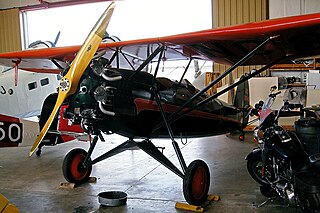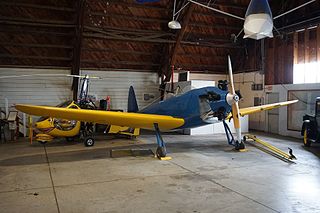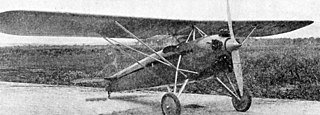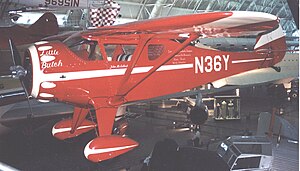
The Monocoupe 90 was a two-seat, light cabin airplane built by Donald A. Luscombe for Monocoupe Aircraft. The first Monocoupe was built in an abandoned church in Davenport, Iowa, and first flew on April 1, 1927. Various models were in production until the late 1940s.

The Cessna Airmaster, is a family of single-engined aircraft manufactured by the Cessna Aircraft Company. The Airmaster played an important role in the revitalization of Cessna in the 1930s after the crash of the aviation industry during the Great Depression.

The Aeronca L was a 1930s American cabin monoplane designed and built, in small numbers, by Aeronca Aircraft. It differed significantly from other Aeronca planes by the use of radial engines, streamlining, and a cantilever low wing.

The Culver Dart was a 1930s American two-seat light monoplane aircraft produced by the Dart Aircraft Company.

The Cessna Model A is a 1920s American high-wing four-seat tourer built by the Cessna Aircraft Company, the first in a long line of high-wing single-engined monoplanes.

The Meyers OTW was a 1930s United States training biplane designed by Allen Meyers and built by his Meyers Aircraft Company from 1936 to 1944.

The Luscombe Phantom was a 1930s American two-seat cabin monoplane and the first product of the Luscombe Aircraft Engineering Company.

The Waco A series is a range of light American-built twin side-by-side seater sporting biplanes of the early 1930s.

The Mohawk M1C was a 1920s American two or three-seat low-wing monoplane designed and built by Mohawk Aero Corporation of Minneapolis, Minnesota. One M1C was evaluated by the United States Army Air Corps in 1930 as the YPT-7 Pinto for use as a primary trainer.

The Pasped W-1 Skylark is a 1930s American two-seat single-engined cabin monoplane designed and built by the Pasped Aircraft Company of Glendale, California.

The Davis D-1 is an American light two-seat parasol-winged monoplane of the late 1920s.

The Howard DGA-18 was an American two-seat basic training aircraft designed and built by the Howard Aircraft Corporation for the United States Civil Pilot Training Program.
The St. Louis C2 Cardinal family are a series of light sport monoplanes built by the St. Louis Aircraft Corporation during the peak of the Lindbergh Boom after the Spirit of St. Louis flight of 1927.

The Loening SL was an American submarine-based reconnaissance flying boat designed and built by Loening Aeronautical Engineering for the United States Navy.

The Eastman E-2 Sea Rover, also called the Beasley-Eastman E-2 Sea Rover, was a light seaplane built in the late 1920s for business and shuttle use.
The Redfern Nieuport 17/24 is an American homebuilt aircraft that was designed by Walter Redfern and produced by the Walter Redfern Company of Post Falls, Idaho, based upon the First World War Nieuport 17 and Nieuport 24 fighter aircraft. When it was available the aircraft was supplied in the form of plans for amateur construction.

The Sands Fokker Dr.1 Triplane is an American homebuilt aircraft that was designed by Ron Sands Sr of Mertztown, Pennsylvania, and produced by Wicks Aircraft and Motorsports. It is a full-sized replica fighter aircraft based upon the 1917-vintage Fokker Dr.1. The aircraft is supplied as a kit and in the form of plans for amateur construction.

The Sikorsky S-33 Messenger was an American two-seat sesqiuplane designed and built by the Sikorsky Manufacturing Corporation in 1925.

The Inland Sport series of parasol wing, sport and training side-by-side two seaters, introduced between 1928 and 1930, differed chiefly in their engines. They used three different radial engines, more than doubling the Sport's power over two years of development. 34 examples were built and frequently re-engined.

The Huntington H-11 Governor was a two-seat cabin monoplane with a high, cantilever wing built in the United States and first flown around 1930. Three were completed.



















